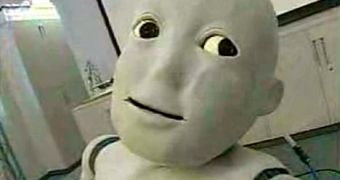Robots have been part of human imagination for longer than you think. Though modern science-fiction literary genre has made them so famous, that they've become universal brands, like "Robocop", "Terminator", "Data", "R2-D2" or "iRobot", they have been present in mythology long before.
When it comes to robots, so far, Japan rules. They're a few generations over the Americans and a century over any other competitor in the field. Sony's AIBO was the first robot dog to recognize words and objects, and Honda's ASIMO is the first humanoid robot that can walk on two feet in a manner resembling human locomotion at up to 6 km/h (3.7 mph).
Scientists studying robot applications encounter many problems in their endeavor, and they usually turn to Mother Nature to solve their problems. A new Japanese robot that looks like a child was the center of attention last week. It is able to mimic human facial expressions, to roll around on the floor and to say words with a synthetic voice.
Called CB2, the robot has a biomimetic body, equipped with dozens of actuators that can replicate muscles and sensors to simulate touch and hearing, while tiny cameras substitute for eyes. Walking is a bit problematic, but in this aspect too, he's mimicking a child, requiring the support of an adult and having shaky legs, exactly like those of a child learning to walk.
When CB2's shoulders are tapped, it blinks as if surprised, stops moving, and turns its gaze toward the person who touched it. It will also try and grab a toy dangled in front of it.
The manufacturers of CB2 said that it could help scientists improve their understanding of various learning processes in children, like the way they develop human relation skills, learn language, recognize objects and interact with other people. They also want to write software allowing it to walk and talk like a three-year-old.
Humanoid robots are about to become reality sooner than you think, and as you would expect, they will feature superhuman characteristics, like heightened senses, physical strength and computational abilities, but first, scientists have to learn how to replicate the functioning principles of biological organisms before applying them to artificial ones.

 14 DAY TRIAL //
14 DAY TRIAL //